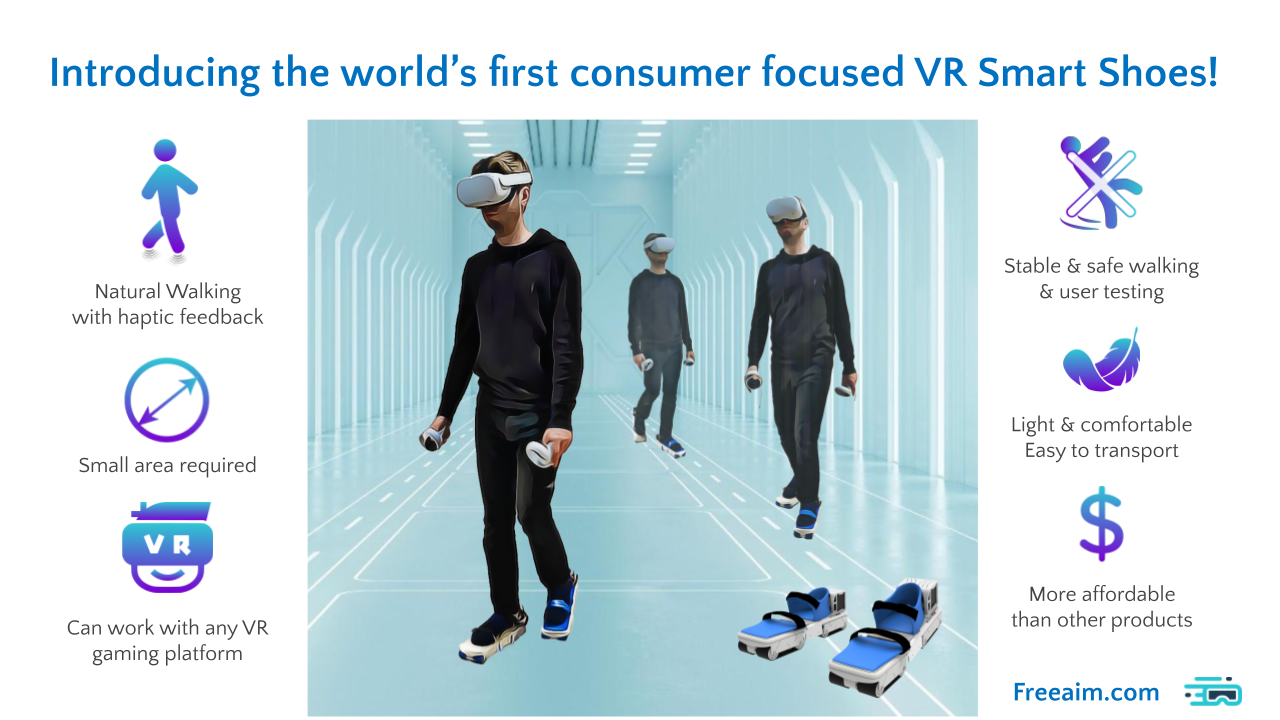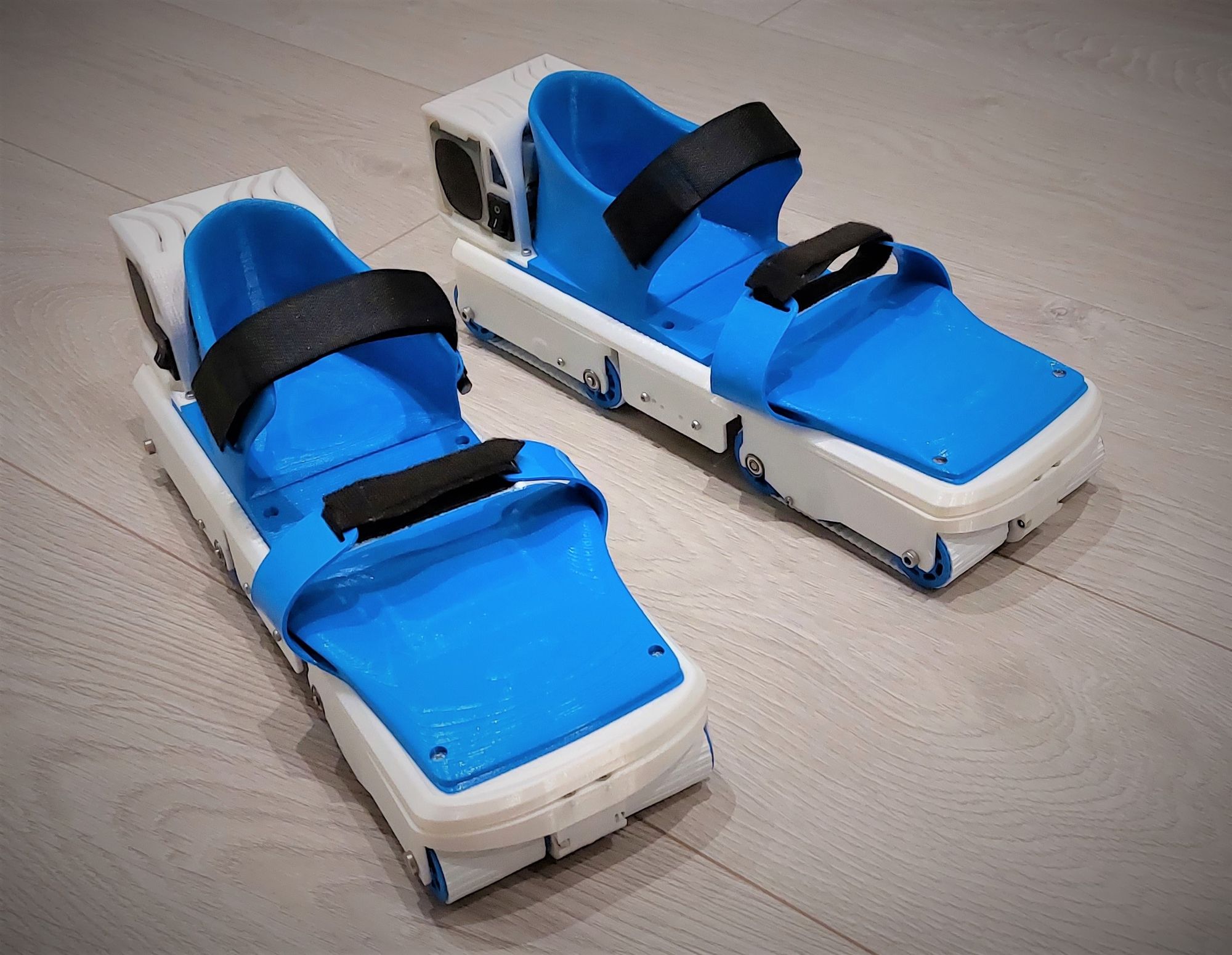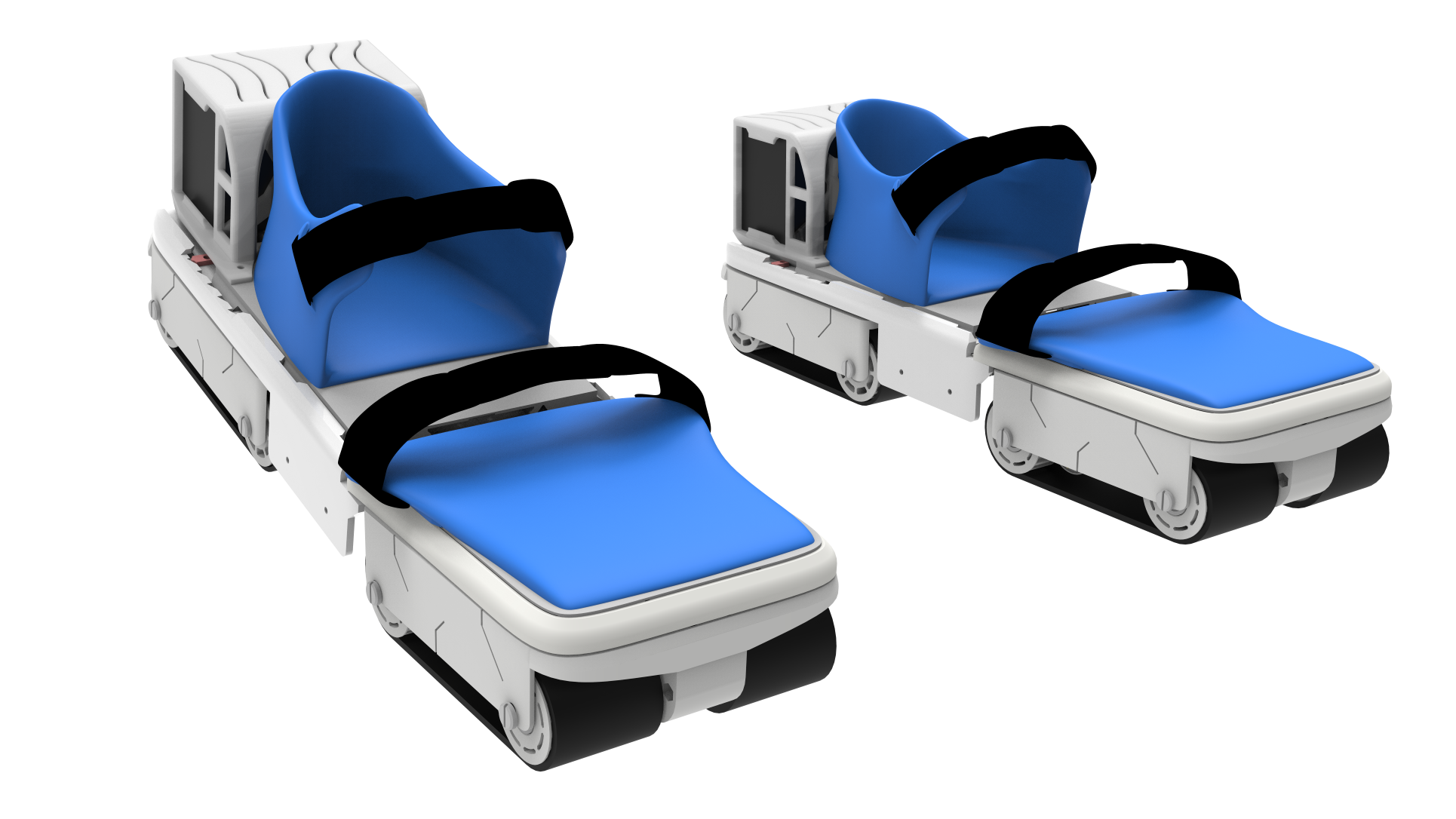Exclusive Interview with Ashley Foxcroft founder of Freeaim VR Shoes
Today I have a special treat for VR Fitness and Sports enthusiasts, we have an exclusive interview with Ashley Foxcroft, the founder and designer of Freeaim VR shoes.

Today I have a special treat for VR Fitness and Sports enthusiasts, we have an exclusive interview with Ashley Foxcroft, the founder and designer of Freeaim VR shoes.
Let’s give you a quick taster of what Freeaim are all about.
“Freeaim's innovative VR Shoes let you walk naturally in VR across infinite distances and in any direction, while in the real world it actively keeps you safely inside a small play area”.
“Our aim is to provide incredible immersion, ease of use and affordability, bringing realistic VR movement mainstream for gaming, fitness, training and more!”
Quick feature list: Haptic Feedback, Kinetic Feedback and Foot Tracking, Comfortable and lightweight design and compatible with most VR Headsets.

Mark: Hi Ashley, great to meet you and share your and Freeaims story with Simulation Magazine and it's readers.
I am sure there have been many twists and turns along the way as is common with all startups, and even more so with hardware, so what I’d like to do is dig a little deeper and and let our readers get to know more about you, the company, and product and how you got to this place in time.
Ashley: Great to meet you Mark, it’s a long story!
I was really into VR as soon as it became available to consumers, I backed the oculus kickstarter and I was one of the first to try a HTC Vive.
XR (mixed reality, VR+AR) has evolved significantly over the years but to me it’s still finding its feet and one thing I always felt was missing right from the start was the ability to move around in a natural way with total freedom.
Even when I moved all the furniture out of the way (much to my wife’s annoyance), I could only walk a few steps before I hit a virtual wall, or the cable pulled the VR headset off my head. Luckily we have wireless VR headsets now, but the issue of moving around still persists and I’m committed to finding the best solution.
I’m sure most people who have used VR would agree that moving around like a floating ghost with a joystick, or pointing & clicking to a destination is not immersive at all. I think this is an area of VR that really lacks good solutions and is just begging for the right technology to be discovered.
Mark: Yes agreed, and especially when you’re floating around with no legs! Anyway you were saying..
Ashley: I started working on VR locomotion back in 2018; that’s the technical term for this type of technology. I started with a motorised platform that consisted of a large array of little treadmills that enabled movement in any direction. This prototype worked but it was very complex, too many moving parts and the development costs were too high for me to self-fund.
This was intended to be a lower cost and smaller alternative to the Infinadeck motorised VR treadmill which is very large and widely reported to cost around $50k; I was aiming for 1/10 of that price.
This is when I came to the realisation that if the motorised technology could be built into a shoe rather than spread across a large platform, this would lead to a much more affordable, compact and convenient solution, however there were significant technical challenges to achieving this and we have worked exceptionally hard to get all the engineering trade-offs just right, resulting in a great design.
It was around early 2020 when I had finished building the first pair of VR shoes. This was very basic, just some motors wired straight to a power supply, but I was encouraged enough to keep going.
Version 3 had the necessary electronics and software to make it work with VR and I shared this video on YouTube which had 12k views. What really convinced me that this technology was viable was not the great feedback from social media, but the feeling I had when using it in VR: It felt really natural and it was the most immersive experience I’d ever had.
The company is growing; we have a few talented people contributing and a small office where we can also give demonstrations. We’re always fundraising too, with grants and other investments.
Mark: So what you’re essentially saying is, you're no stranger to the VR world, ha! What amazes me with all entrepreneurial types is they all share the same or similar traits of an inquisitive mind and the bloody minded will to overcome all problems to get to the end goal, that takes foresight, fortitude and a lot of sleepless nights.
Mark: So how exactly do VR shoes work?
Ashley: Sure, the main purpose of the VR shoes is to keep you inside a small area, while in VR you have total freedom of movement, essentially turning a small area into an infinite area.
The VR shoes do the opposite of whatever you might do while walking around and in any direction. Each VR shoe is like a small autonomous robot that can handle the entire weight of a human while walking and it’s fully wireless too.
The VR shoes can move sideways without the user noticing, often called omni-directional; this is very important and was a key challenge to solve. Without the ability to move in any direction, the user will gradually drift away from where they started because they take side-steps and many other little steps as they move around.
So the VR shoes are constantly correcting the position of the user, like gravity, they are always moving the user back to where they started.
It can be hard to explain so the videos definitely help to understand the concept.
Mark: So what about Fitness and eSport? What kind of benefits will there be compared to conventional exercise?
Ashley: I recently came across this term: exergaming, or exergames (gamified exercise) which I think sounds great and it fits really well with the VR shoes. The physical activity is almost the same as using a Gym Treadmill, albeit moving in any direction.
The use cases are very broad; Gaming and eSports is the most obvious one; think Call of Duty and open world adventures like the Skyrim and Fallout games. This will help people to get exercise that might not be too keen on going to a gym or doing other traditional sports.
There are other use cases like training and simulation for public sector service (fire, police), businesses and universities etc. And then there are more niche applications like medical rehabilitation.
The VR shoes have potential to be used in a similar way to how Peloton packages their exercise machines along with immersive and social interactive content. For now there are plenty of games and social apps like VRChat already available, but we hope to provide our own exergames in the near future.
Mark: Ok, so let's talk about the why, there are already a couple of VR products on the market, one even a pair of shoes the other a large baseplate type platform where the user needs to be tethered to, of course I’m talking about KatWalk VR here. So my question is, did you look at these products and think that you could do it better, do it cheaper, or both?
I mean, was there an ‘aha’ moment when you finally had the idea for Freeaim shoes, or was this like most things, a longer process with marginal gains where you add or eliminate micro ideas and end up with “the product” like the MVP you have today?
Ashley: Sure, there have been many attempts by others to solve VR locomotion, however I think all of these other solutions have missed the mark in some way. I’m not saying Freeaim’s VR shoes are perfect but overall I think the product ticks all the boxes for what consumers and businesses would like and we have done market research to understand that.
I don’t think there was a ‘Aha’ moment; but understanding the competitive landscape is a long process that started even before I designed anything. I have researched and tested other products and my experience with these helps me to figure out how to do it better and cheaper.
The other pair of shoes that you mention is probably Cybershoes, however that only works sitting down on a stool that swivels around.
There are some little wheels underneath that measure speed so you can move in VR, but because the user cannot stand-up it does severely limit what it can be used for.
The KatWalkC is a large plastic disk with a support harness, which is very heavy (~65kg). I own the latest versions (for research) and so I have first hand experience. It works by holding the upper body in place so the user can slide their feet with low friction shoes.
The high cost (£1.5k to £2k depending on model) and inconvenience of having such a large object as a permanent feature in the home, could all be justified if it worked well and gave a good experience, but sadly it does not in my opinion. It’s like when you first learn to roller-skate or ice-skate, it’s hard to control and it doesn't feel like walking.
I don't mean to sound too critical of any competitors, they have successfully manufactured and released products that work at some level which is not easy to do. Freeaim has not gotten that far yet, but I do believe that we have a much better solution for natural & immersive walking in VR that’s far more convenient and at a much more affordable price point.
Mark: Yes, I was thinking of the Cybershoes, KatWalkVR I think has use cases better aligned outside of walking and running, swimming would be obvious.
Ok, I know this question will be of real interest to our readers as it adds the ultimate context for use cases.
With that in mind, I’d be interested to know as part of your product testing and R&D, what games have you used to benchmark the progress and performance of the Freeaim shoes?

Ashley: Sure, we have the VR shoes working with most VR games on steam that involve moving around. Our favourites for testing include open world space sim ‘No Man’s Sky’, the amazing Half Life Alyx game and an FPS game called ‘Pavlov’, plus many others. We have also been testing VR apps that are used for training, such as ‘Aircraft Ground Handling Simulator’, which is used for training people to work around aircraft, which you will have seen in the frist video.
Mark: That’s quite varied!
The other question my readers will be interested in is the use of AI. Can the Freeaim shoes ‘learn’ user habits, balance, traits etc, or is that something for down-the-line?
Ashley: At the moment, nothing like that is used but in the near future, we plan to use Machine Learning so the VR shoes can configure themselves to work optimally with different users.
The VR shoes collect a lot of data and with permission from the user, we can perform data analytics to improve the system. We can already measure people's weight and their patterns of walking (gait) and we plan to do so much more with this data.
The way the VR shoes behave at the moment can be controlled by the user and we will probably have a beginner mode and experienced mode that adjusts key parameters like acceleration.
If we use AI, the VR shoes may end-up taking you to the shops if it gets talking to Alexa (joke!).
Mark: Hahaha, I’ll remember to take my wallet out of my pocket when I use them then!
What about haptics? the use of haptics is common in VR, all the hand controllers have it enabled, and for a while even the various Apple VR rumour mills mentioned in-HMD haptics, but excitingly, I see you are using haptics in the shoes, so I guess I’m intrigued to find out what type of feel, sensations and feedback to the user is available, and how are they triggered in-game?

Ashley: We are very excited about our tech road-map, which as you mentioned includes haptic feedback, but also feet and lower leg visualisation in VR, and a User Interface inside VR which will include a virtual control panel for the VR shoes and notifications etc.
Plus we will have training tutorials and possibly partner with other games developers to create games that can really showcase the VR shoes. We have a great idea for a Pac-Man inspired game, where you have to navigate a maze while being chased by monsters or robots.
Whilst on the topic of haptics, the prototype VR shoes already have multiple haptic motors, and we plan to update the haptics technology to high definition like what you would find in the latest gaming controllers, but first we need to work on the software implementation which is a little complex. At the moment, we can give simple feedback patterns when you touch the ground, and we can also use the haptic feedback to alert the user to different conditions like a low battery etc.
When we release a Software Development Kit (SDK), we can get information from inside the VR game such as what kind of ground the user is walking on. Walking on lava, water, grass, snow, etc could give different sensations especially with HD haptics. The full implementation of the haptic feedback depends on getting game developers to integrate our SDK so we need to launch the product with a more basic version which will get software updates.
Mark: My mind is racing with use cases, and many I can adopt within my own game, this all seems like (if you pardon the pun) a giant step forward.
So Ashley, I see you have the Innovate UK and Digital Catapult logos on your website. How did you find the process dealing with Innovate UK and Digital Catapult, and what were the outputs from that experience, would you recommend other startups going that route?
Ashley: I definitely recommend working with any of the Catapults, they are all very well organised. The Digital Catapult has accelerator programs but they are quite specific; there might be one for AI, or Augmented Reality, so if your project fits then these programmes are reality great.
The accelerator programmes are not necessarily repeated, they seem to be run just one or twice and I think this is because they follow the market quite closely in terms of what investors are looking for and to be aligned with government strategy.
Mark: Digital Catapult were really helpful to me in my first startup, they even managed to get me $100k of AWS credits, that's a huge leg up for a new, fledgling company. I still speak to people from there today.
Ashley: All I want to say about Innovate UK is that you have to work very hard to get the funding; I definitely don’t consider it to be free money. There is a lot of reporting and meetings etc, and you have to work very hard to deliver, but without the support of Innovate UK, Freeaim couldn't have got this far, it was the first money into the company so eternally grateful to Innovate UK for supporting start-ups.
Mark: I know many companies that have gone through the funding process for smart grants and have failed, it’s super tough, so I have to commend you for getting through that process.
So, Ashley, thanks for your valuable time today. It's been a real pleasure getting to know you and Freeaim, I think you have provided our readers with a valuable insight to what is indeed possible in VR and a glimpse of the not too distant future.
I look forward to following your progress and look forward to your launch on Kickstarter later in the year, and i'll be sure to put a link to the Kickstarter campaign once it's launched.





